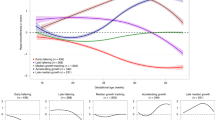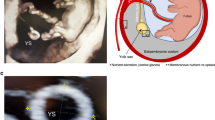Abstract
Background/objectives
Maternal dietary patterns were associated with embryonic growth and congenital anomalies. We aim to evaluate associations between early first trimester maternal dietary patterns and embryonic morphological development among pregnancies with non-malformed outcome.
Subjects/methods
A total of 228 strictly dated, singleton pregnancies without congenital malformations were enrolled in a periconceptional hospital-based cohort. Principal component analysis was performed to extract early first trimester maternal dietary patterns from food frequency questionnaires. Serial transvaginal three-dimensional ultrasound (3D US) scans were performed between 6+0 and 10+2 gestational weeks and internal and external morphological criteria were used to define Carnegie stages in a virtual reality system. Associations between dietary patterns and Carnegie stages were investigated using linear mixed models.
Results
A total of 726 3D US scans were included (median: three scans per pregnancy). The ‘high fish and olive oil and low meat’ dietary pattern was associated with accelerated embryonic development in the study population (β = 0.12 (95%CI: 0.00; 0.24), p < 0.05). Weak adherence to this dietary pattern delayed embryonic development by 2.1 days (95%CI: 1.6; 2.6) compared to strong adherence. The ‘high vegetables, fruit and grain’ dietary pattern accelerated embryonic development in the strictly dated spontaneous pregnancy subgroup without adjustment for energy intake.
Conclusions
Early first trimester maternal dietary patterns impacts human embryonic morphological development among pregnancies without congenital malformations. The clinical meaning of delayed embryonic development needs further investigation.
This is a preview of subscription content, access via your institution
Access options
Subscribe to this journal
Receive 12 print issues and online access
$259.00 per year
only $21.58 per issue
Buy this article
- Purchase on Springer Link
- Instant access to full article PDF
Prices may be subject to local taxes which are calculated during checkout


Similar content being viewed by others
References
Fleming TP, Watkins AJ, Sun C, Velazquez MA, Smyth NR, Eckert JJ. Do little embryos make big decisions? How maternal dietary protein restriction can permanently change an embryo’s potential, affecting adult health. Reprod Fertil Dev. 2015;27:684–92.
Williams L, Seki Y, Vuguin PM, Charron MJ. Animal models of in utero exposure to a high fat diet: a review. Biochim Biophys Acta. 2014;1842:507–19.
Sinclair KD, Watkins AJ. Parental diet, pregnancy outcomes and offspring health: metabolic determinants in developing oocytes and embryos. Reprod Fertil Dev. 2013;26:99–114.
Steegers-Theunissen RP, Twigt J, Pestinger V, Sinclair K. The periconceptional period, reproduction and long-term health of offspring: the importance of one-carbon metabolism. Hum Reprod Update. 2013;19:640–55.
Bouwland-Both MI, Steegers-Theunissen RP, Vujkovic M, Lesaffre EM, Mook-Kanamori DO, Hofman A, et al. A periconceptional energy-rich dietary pattern is associated with early fetal growth: the Generation R study. BJOG. 2013;120:435–45.
van Uitert EM, van Ginkel S, Willemsen SP, Lindemans J, Koning AH, Eilers PH, et al. An optimal periconception maternal folate status for embryonic size: the Rotterdam Predict study. BJOG. 2014;121:821–9.
O’Rahilly R. Human embryo. Nature. 1987;329:385.
O’Rahilly R, Müller F. Developmental stages in human embryos: revised and new measurements. Cells Tissues Organs. 2010;192:73–84.
Blaas HG. The examination of the embryo and early fetus: how and by whom? Ultrasound Obstet Gynecol. 1999;14:153–8.
Blaas HG, Eik-Nes SH, Berg S, Torp H. In-vivo three-dimensional ultrasound reconstructions of embryos and early fetuses. Lancet. 1998;352:1182–6.
Rousian M, Koning AH, van Oppenraaij RH, Hop WC, Verwoerd-Dikkeboom CM, van der Spek PJ, et al. An innovative virtual reality technique for automated human embryonic volume measurements. Hum Reprod. 2010;25:2210–6.
Verwoerd-Dikkeboom CM, Koning AH, Hop WC, Rousian M, Van Der Spek PJ, Exalto N, et al. Reliability of three-dimensional sonographic measurements in early pregnancy using virtual reality. Ultrasound Obstet Gynecol. 2008;32:910–6.
Verwoerd-Dikkeboom CM, Koning AH, van der Spek PJ, Exalto N, Steegers EA. Embryonic staging using a 3D virtual reality system. Hum Reprod. 2008;23:1479–84.
Steegers-Theunissen RP, Verheijden-Paulissen JJ, van Uitert EM, Wildhagen MF, Exalto N, Koning AH, et al. Cohort profile: the rotterdam periconceptional cohort (predict study). Int J Epidemiol. 2016;45:374–81.
Robinson HP. Sonar measurement of fetal crown rump length as means of assessing maturity in first trimester of pregnancy. Br Med J. 1973;4:28–31.
Siebelink E, Geelen A, de Vries JH. Self-reported energy intake by FFQ compared with actual energy intake to maintain body weight in 516 adults. Br J Nutr. 2011;106:274–81.
Verkleij-Hagoort AC, de Vries JH, Stegers MP, Lindemans J, Ursem NT, Steegers-Theunissen RP. Validation of the assessment of folate and vitamin B12 intake in women of reproductive age: the method of triads. Eur J Clin Nutr. 2007;61:610–5.
Netherlands Nutrition Centre. NEVO-tabel; Nederlands Voedingsstoffenbestand 2011, RIVM/Voedingscentrum, Den Haag. 2011, https://www.rivm.nl/en/Topics/D/Dutch_Food_Composition_Database/Publications.
Marjonen H, Sierra A, Nyman A, Rogojin V, Gröhn O, Linden AM, et al. Early maternal alcohol consumption alters hippocampal DNA methylation, gene expression and volume in a mouse model. PLoS One. 2015;10:e0124931.
van Uitert EM, van der Elst-Otte N, Wilbers JJ, Exalto N, Willemsen SP, Eilers PH, et al. Periconception maternal characteristics and embryonic growth trajectories: the Rotterdam Predict Study. Hum Reprod. 2013;28:3188–96.
Hoffmann K, Schulze MB, Achienkiewitz A, Nothlings U, Boeing H. Application of a new statistical method to derive dietary patterns in nutritional epidemiology. Am J Epidemiol. 2004;159:935–44.
Vujkovic M, Ocke MC, van der Spek PJ, Yazdanpanah N, Steegers EA, Steegers-Theunissen RP. Maternal western dietary patterns and the risk of developing a cleft lip with or without a cleft palate. Obstet Gynecol. 2007;110:378–84.
Rousian M, Koning AH, van der Spek PJ, Steegers EA, Exalto N. Virtual reality for embryonic measurements requiring depth perception. Fertil Steril. 2011;95:773–4.
Ramirez-Zea M. Validation of three predictive equations for basal metabolic rate in adults. Public Health Nutr. 2005;8:1213–28.
Parisi F, Rousian M, Huijgen NA, Koning AH, Willemsen SP, de Vries JH, et al. Periconceptional maternal ‘high fish and olive oil, low meat’ dietary pattern is associated with increased embryonic growth: The Rotterdam Periconceptional Cohort (Predict Study). Ultrasound Obstet Gynecol. 2017;50:709–16.
Rogers I, Emmett P, Ness A, Golding J. Maternal fish intake in late pregnancy and the frequency of low birth weight and intrauterine growth retardation in a cohort of British infants. J Epidemiol Community Health. 2004;58:486–92.
Thorsdottir I, Birgisdottir BE, Halldorsdottir S, Geirsson RT. Association of fish and fish liver oil intake in pregnancy with infant size at birth among women of normal weight before pregnancy in a fishing community. Am J Epidemiol. 2004;160:460–5.
Stratakis N, Roumeliotaki T, Oken E, Barros H, Basterrechea M, Charles MA, et al. Fish intake in pregnancy and child growth: a pooled analysis of 15 European and US birth cohorts. JAMA Pediatr. 2016;170:381–90.
Braga DP, Halpern G, Setti AS, Figueira RC, Iaconelli A Jr, Borges E Jr.. The impact of food intake and social habits on embryo quality and the likelihood of blastocyst formation. Reprod Biomed Online. 2015;31:30–38.
Hammiche F, Vujkovic M, Wijburg W, de Vries JH, Macklon NS, Laven JS, et al. Increased preconception omega-3 polyunsaturated fatty acid intake improves embryo morphology. Fertil Steril. 2011;95:1820–3.
Obermann-Borst SA, Vujkovic M, de Vries JH, Wildhagen MF, Looman CW, de Jonge R, et al. A maternal dietary pattern characterised by fish and seafood in association with the risk of congenital heart defects in the offspring. BJOG. 2011;118:1205–15.
Ramaiyan B, Bettadahalli S, Talahalli RR. Dietary omega-3 but not omega-6 fatty acids down-regulate maternal dyslipidemia induced oxidative stress: A three generation study in rats. Biochem Biophys Res Commun. 2016;477:887–94.
Ornoy A. Embryonic oxidative stress as a mechanism of teratogenesis with special emphasis on diabetic embryopathy. Reprod Toxicol. 2007;24:31–41.
Waters SM, Coyne GS, Kenny DA, MacHugh DE, Morris DG. Dietary n-3 polyunsaturated fatty acid supplementation alters the expression of genes involved in the control of fertility in the bovine uterine endometrium. Physiol Genom. 2012;44:878–88.
Sidhu KS. Health benefits and potential risks related to consumption of fish or fish oil. Regul Toxicol Pharmacol. 2003;38:336–44.
Higa R, Roberti SL, Musikant D, Mazzucco MB, White V, Jawerbaum A. Effects of maternal dietary olive oil on pathways involved in diabetic embryopathy. Reprod Toxicol. 2014;49:185–95.
Xia W, Chiu YH, Williams PL, Gaskins AJ, Toth TL, Tanrikut C, et al. Men’s meat intake and treatment outcomes among couples undergoing assisted reproduction. Fertil Steril. 2015;104:972–9.
Knudsen VK, Orozova-Bekkevold IM, Mikkelsen TB, Wolff S, Olsen SF. Major dietary patterns in pregnancy and fetal growth. Eur J Clin Nutr. 2008;62:463–70.
Larqué E, Zamora S, Gil A. Dietary trans fatty acids in early life: a review. Early Hum Dev. 2001;65(Suppl):S31–S41.
Zhu J, Li M, Chen L, Liu P, Qiao J. The protein source in embryo culture media influences birthweight: a comparative study between G1 v5 and G1-PLUS v5. Hum Reprod. 2014;29:1387–92.
Mantikou E, Youssef MA, van Wely M, van der Veen F, Al-Inany HG, Repping S, et al. Embryo culture media and IVF/ICSI success rates: a systematic review. Hum Reprod Update. 2013;19:210–20.
Holst S, Kjær SK, Jørgensen ME, Damm P, Jensen A. Fertility problems and risk of gestational diabetes mellitus: a nationwide cohort study. Fertil Steril. 2016;106:427. e1
Jacques M, Freour T, Barriere P, Ploteau S. Adverse pregnancy and neo-natal outcomes after assisted reproductive treatment in patients with pelvic endometriosis: a case-control study. Reprod Biomed Online. 2016;32:626–34.
Bottomley C, Daemen A, Mukri F, Papageorghiou AT, Kirk E, Pexsters A, et al. Assessing first trimester growth: the influence of ethnic background and maternal age. Hum Reprod. 2009;24:284–90.
Mook-Kanamori DO, Steegers EA, Eilers PH, Raat H, Hofman A, Jaddoe VW. Risk factors and outcomes associated with first-trimester fetal growth restriction. JAMA. 2010;303:527–34.
Jaddoe VW, de Jonge LL, Hofman A, Franco OH, Steegers EA, Gaillard R. First trimester growth restriction and cardiovascular risk factors in childhood. BMJ. 2014;348:g14.
Vujkovic M, Steegers EA, Looman CW, Ocké MC, van der Spek PJ, Steegers-Theunissen RP. The maternal Mediterranean dietary pattern is associated with a reduced risk of spina bifida in the offspring. BJOG. 2009;116:408–15.
Gluckman PD, Hanson MA. Developmental origins of disease paradigm: a mechanistic and evolutionary perspective. Pediatr Res. 2004;56:311–7.
Skinner MK. What is an epigenetic transgenerational phenotype? F3 or F2. Reprod Toxicol. 2008;25:2–6.
Steegers-Theunissen RP, Steegers EA. Embryonic health: new insights, mHealth and personalised patient care. Reprod Fertil Dev. 2015;27:712–5.
Acknowledgements
We thank the Rotterdam periconception cohort team for contributions to recruitment, data collection, and cleaning.
Author information
Authors and Affiliations
Corresponding author
Ethics declarations
Conflict of interest
No conflicts of interests are declared. RST is CSO of the startup company Slimmere Zorg and CEO of eHealth Care Solutions.
Rights and permissions
About this article
Cite this article
Parisi, F., Rousian, M., Steegers-Theunissen, R.P.M. et al. Early first trimester maternal ‘high fish and olive oil and low meat’ dietary pattern is associated with accelerated human embryonic development. Eur J Clin Nutr 72, 1655–1662 (2018). https://doi.org/10.1038/s41430-018-0161-7
Received:
Revised:
Accepted:
Published:
Issue Date:
DOI: https://doi.org/10.1038/s41430-018-0161-7
This article is cited by
-
Ernährung und Nahrungsergänzungsmittel bei Kinderwunsch der Frau
Gynäkologische Endokrinologie (2019)



